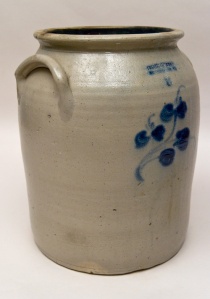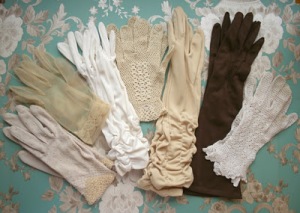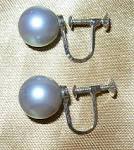Monthly Archives: May 2013
Stoneware Jars and Crocks
 An acquaintance of mine recently hired an estate sales professional to handle her late mother-in-law’s houseful of Stuff. As the woman walked through the house for the first time to assess the Stuff, she pointed to various items and said, “This is worth about such-and-such.” On the porch was a dirty, clunky stoneware jar about 2 feet tall. As the woman bent to examine it more closely, my acquaintance said that she was about to throw that ugly old thing away. “Don’t do that,” said the estate sales professional–“it’s worth about $8,000.”
An acquaintance of mine recently hired an estate sales professional to handle her late mother-in-law’s houseful of Stuff. As the woman walked through the house for the first time to assess the Stuff, she pointed to various items and said, “This is worth about such-and-such.” On the porch was a dirty, clunky stoneware jar about 2 feet tall. As the woman bent to examine it more closely, my acquaintance said that she was about to throw that ugly old thing away. “Don’t do that,” said the estate sales professional–“it’s worth about $8,000.”
Clunky old stoneware crocks or storage vessels have significant monetary value, even though they may not look attractive to you. Folk art ceramics of all sorts are highly collectible. Take them to two or three antiques dealers for verification and ask what they would pay.
Second Edition Available Now
 The second edition of STUFF AFTER DEATH has been posted on amazon and Barnes & Noble sites for Kindles and Nooks, with updated links to relevant sites and new information. No price change, still just $4.99. Coming soon is a paperback version that can be purchased by people who don’t read on electronic devices or who want to write in the book, tear out pages, or give it as a gift. I didn’t originally plan to have a paperback version, but was persuaded by several requests from professional organizers and move managers who want to give the book to clients. I hope that will be available soon. It’s harder that you think to turn an ebook into a real book!! (Well, harder than I thought, anyway . . . )
The second edition of STUFF AFTER DEATH has been posted on amazon and Barnes & Noble sites for Kindles and Nooks, with updated links to relevant sites and new information. No price change, still just $4.99. Coming soon is a paperback version that can be purchased by people who don’t read on electronic devices or who want to write in the book, tear out pages, or give it as a gift. I didn’t originally plan to have a paperback version, but was persuaded by several requests from professional organizers and move managers who want to give the book to clients. I hope that will be available soon. It’s harder that you think to turn an ebook into a real book!! (Well, harder than I thought, anyway . . . )
Don’t try this test on your diamond!
 You may have heard that a real diamond will scratch glass and an imitation one won’t. If only it were that easy! Many high quality imitation diamonds are harder than glass, so even some of the fakes will scratch glass.
You may have heard that a real diamond will scratch glass and an imitation one won’t. If only it were that easy! Many high quality imitation diamonds are harder than glass, so even some of the fakes will scratch glass.
Don’t rely on these myths to determine whether your inherited diamond-looking piece of jewelry is genuine or not. Take it to a reputable, local jewelry, one who has been in business for many years, and he or she will tell you at no cost whether it is genuine or not. They will not appraise it at no cost, and they probably aren’t able to anyway. Pay for an appraisal from an experienced CGA or Certified Gemologist Appraiser. These people have the training to judge your jewelry and, equally important, they have no interest in buying it, so they have no incentive to lowball their estimates.
So how did this myth get started? It probably was true in the past, when imitation diamonds were made of something called “paste.” Not the sort of paste you used in kindergarten to glue lace to your Valentine, this word meant a type of glass with a high lead content that was used to make imitation stones. According to the Encyclopedia Britannica, the Romans were the first to make this sort of imitation stone. For all you chemists, here’s the lowdown:
“Before 1940 most imitation gems were made from glass with a high lead content. Such glasses were called paste because the components of the mixture were mixed wet to ensure a thorough and even distribution. Colourless paste is commonly formulated from 300 parts of silica (silicon dioxide, SiO2), 470 of red lead (a lead oxide, Pb3O4), 163 of potassium carbonate (K2CO3), 22 of borax (a sodium borate, Na2B4O7·10H2O), and 1 of white arsenic (arsenic oxide, As2O3). Pigments may be added to give the paste any desired colour: chromium compounds for red or green, cobalt for blue, gold for red, iron for yellow to green, manganese for purple, and selenium for red.”
Should you sell those old accessories to a vintage clothing store?
 Vintage shops sell more than clothing. They also carry period accessories such as cuff links, stickpins, hatpins, tie clips, hats, gloves, scarves, coats, shoes, shawls, lace, fans, evening bags, handkerchiefs, furs, and jewelry.
Vintage shops sell more than clothing. They also carry period accessories such as cuff links, stickpins, hatpins, tie clips, hats, gloves, scarves, coats, shoes, shawls, lace, fans, evening bags, handkerchiefs, furs, and jewelry.
If the jewelry, cuff links, hatpins, and tie clips you want to get rid of is made of gold or silver (there will be marks like 18K, 14K, or 10K on the gold and STER, STERLING, 925, or 900 on the silver, or even PLAT or PT for platinum) and has stones, chances are the stones are genuine. It isn’t common to put cheap, “paste” stones in silver or gold settings. Same with pearls–pearls with 14K gold clasps are probably genuine. These pieces should be taken to a reputable jeweler, preferably two or three, to see what they say. If the metal has no marks, it’s likely the piece is costume jewelry and that is the sort you should take to a vintage clothing shop to sell.
 Speaking of jewelry, one clue in estimating the date of your jewelry is to look at the earrings. Lever-back or screw-back earrings came in around the early years of the 20th century and faded during the forties. The spring clip is a little later, around the thirties and faded in the sixties when pierced ears became fashionable. Not conclusive, but suggestive.
Speaking of jewelry, one clue in estimating the date of your jewelry is to look at the earrings. Lever-back or screw-back earrings came in around the early years of the 20th century and faded during the forties. The spring clip is a little later, around the thirties and faded in the sixties when pierced ears became fashionable. Not conclusive, but suggestive.